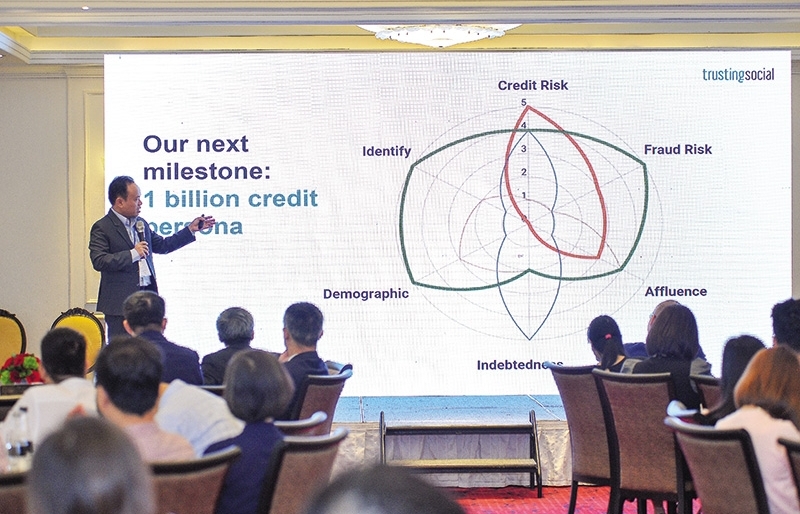Lenders upgrade with digitalisation
 |
| To keep up-to-date with digital trends, retail banks have been forced to come up with innovations such as e-commerce platforms that allow new payment methods for customers |
Having food delivered right to one’s own doorstep or hopping on a Grab bike could not get any simpler thanks to innovations on smart devices. No cash or physical bank card is needed as everything is conducted through a simple digital platform.
Carrying cash around is no longer necessary with digital payment services stronger than ever. Evidence for this can be seen in the rise of banking and financial technology (fintech) apps developed for use nationwide. In addition, foreign mobile payment services like Samsung have been in use since 2017, whilst Apple Pay, and possibly other mobile payment platforms are set to enter the market in the near future.
According to Shin Dong Min, CEO of Shinhan Bank Vietnam, the bank’s digital platform now accounts for about 70 per cent of total transactions. Indeed, the lender has been pursuing a digital banking strategy for years with the number of transactions processed via mobile and internet banking reaching 25 per cent.
To continue harnessing digital banking developments in Vietnam, the CEO said Shinhan Bank has taken the initiative by launching a brand-new mobile app called SOL as part of an attempt to bring convenience and satisfaction to its retail customers.
“They will have the chance to experience simple, real-time transfers and payment transactions, personalised interface and multi options of user verification,” he said. “After one month, we have received lots of positive feedback from individual customers on the SOL application, with the total transactions on mobile banking increasing by around 30 per cent compared to the previous month.”
According to EY’s ASEAN Fintech Census 2018, within the Asia-Pacific region, social media platforms, e-commerce giants and on-demand service providers like ride-hailing Grab are already starting to offer payment methods as a service to consumers.
These factors, when considered as a whole, are progressively transforming the landscape of payment procedures throughout the nation. A country that largely depends on cash is developing into one where up to 40 per cent of the population by 2021 will be using a digital device to pay for everyday necessities, according to Statista, an online statistics, market research and business intelligence portal headquartered in Germany.
Fueled by e-commerce
The rise in digital payments is considered to be an upshot of the booming e-commerce business in Vietnam.
Sabbir Ahmed, country head of Retail Banking and Wealth Management at HSBC Vietnam, noted that the nation has embraced the trend of online shopping. In a country that has some of the highest levels of Internet and smartphone penetration per capita, many consumers enjoy purchasing goods from the comfort of one’s own home. The lender, Ahmed stressed, has seen a faster growth rate of online transactions compared with offline ones, which further illustrates how the nation’s e-commerce sector has enjoyed a boom in recent years.
“We expect to leverage this trend and this in turn will help us deliver the best customer experience and drive business growth,” he said, adding that clients were increasingly looking for mobile and online payment methods.
HSBC Vietnam has therefore partnered with leading local e-commerce merchants such as Lazada, Tiki, Shopee, Agoda, Adayroi and others, to bring attractive offers to their Vietnamese clients.
“The e-commerce and Card Not Present (CNP) platforms are the biggest engines of growth for electronic payments. They have been driven by a smartphone penetration of 55 per cent and one of the highest per capita time spent on social media in Southeast Asia,” noted Harmander Mahal, head of Retail Banking at Standard Chartered Bank Vietnam.
“Today more than 50 per cent of our card transactions are CNP transactions driving business growth and delivering a superior experience for clients,” he said.
Virtual versus physical
Vietnamese consumers have grown increasingly familiar with e-wallets such as MoMo, Timo or Payoo as a substitute for cash or credit and debit cards in recent years. Consumers, especially younger ones, are now comfortable using banking apps or fintech apps and even a whole digital bank that is built into a smartphone.
The 2017 Visa Consumer Payment Attitudes Survey made a statement by saying visiting a physical bank to make a transaction is now regarded as time-consuming and less preferable to going online or using a mobile banking app.
“Increased connectivity, coupled with wider payment methods and form factors have transformed the experience that consumers have in commerce,” wrote the Visa report. “These technologies have enabled consumers to perform device-initiated payments anywhere at any time with their smartphones, and are fast becoming the norm as consumers forego cash, preferring a more seamless, reliable and secure mode of payment.”
The nation’s usage rate of device-initiated payments, meanwhile, is the highest among Southeast Asia nations. According to the survey, 91 per cent of local consumers surveyed said that they have previously made device-initiated payments.
Visa states that on average, bank customers make dozens of payments each week, and there is an increasing trend for these payments to be digital and potentially mobile. It is now commonplace for consumers to access services within a single app. As more pure-play digital banks and fintech companies enter the banking ecosystem, traditional businesses are facing challenges trying to reinvent themselves. These businesses now need to focus on what features consumers are keen on when it comes to mobile banking.
In trying to keep up with trends in the sector, Hanoi-based VPBank has developed its own digital banking arm, called YOLO. The service is designed to offer customers digital access to products and services while technically working in-sync with the lender’s traditional banking system.
Shameek Bhargava, director of YOLO, said the digital bank is paperless and operates alongside the traditional business of VPBank.
“Compared to wallets like MoMo and others, YOLO is a bank, so we can offer interest on deposits which MoMo cannot offer, or we can offer virtual MasterCard instantly,” the director said.
“We can clearly see a move away from plastic payments to emerging payment technologies driven by smart device based platforms. In line with our digital strategy, we have recently launched a virtual credit card for our clients. Here clients can instantly start shopping online with their virtual credit cards and enjoy special online promotions offered by the bank,” said Mahal of Standard Chartered. “The client feedback on virtual credit technology has been very encouraging and we plan to keep building on our virtual credit card platform.”
According to Ahmed of HSBC, the adoption of digital payment continues to rise across Vietnam with key players like Samsung Pay, ZaloPay, MoMo, Payoo and Moca. For some people, their phones are already their wallets and new forms of payment are improving customer experiences.
“But will these phone payments completely replace credit and debit cards? That would depend on the infrastructure being built to support this. HSBC Vietnam always takes into consideration the preferences of Vietnamese credit cardholders before launching suitable products and services during a certain period,” Ahmed added.
| Shin Dong Min, CEO, Shinhan Bank Vietnam
According to statistics and forecasts, the global retail banking market is expecting strong growth in terms of volume as well as changes in characteristics and features. As we believe, there is a strong trend favouring a move away from traditional banking and towards digital banking. In the Vietnamese market, Shinhan Bank, like many other foreign and local credit institutions, recognises the great outlook potential within the market. This is thanks to a young population structure (especially in big cities) as well as a low proportion of people having previous experience in using banking services compared to other countries in the region. In this context, we will take advantage of Shinhan Bank’s unique strengths, which are a strong capital source, competitive financial products and advanced banking technology, coupled with a South Korean standard service and product quality. However, in this circumstance, the biggest challenge for foreign banks in general and for us in particular, is the strong competition from domestic banks in all aspects of service quality, technology, networks, and new products. Sabbir Ahmed, Country head of Retail Banking and Wealth Management, HSBC Vietnam
Regarding future trends of retail banking around the world and ultimately in Vietnam, the banking industry will be well set up to enjoy sustained growth and increased prosperity with many exciting prospects over the next half century. Technology, and how it will continue to change the way people live, work, shop, dine, travel and save, is perhaps one of the most fascinating advances in recent times, and one that presents vast opportunities ahead. For Vietnam, our population is one of the world’s youngest, whilst levels of disposable income are gradually rising across the region. This means that for businesses, bankers and investors, there is a large, dynamic and eager consumer base. Meanwhile, it is easy to see that young Vietnamese consumers are highly likely to want to incorporate online and mobile innovations into multiple aspects of their lives. Amid all this change and potential, it is no wonder that Vietnam has begun to spawn a number of fintech companies. Traditional banks are starting to invest significantly in their digital capabilities to offer a simpler, better, faster and more secure banking and payment experience. This includes working more and more with nimble fintech start-ups to ensure that their services meet the demands of a young, tech-savvy consumer base. Harmander Mahal, Head of Retail Banking, Standard Chartered Bank Vietnam
Global retail banking trends are largely influenced by the increasing pace of what we can now do with technology and the different skills that new players bring to the market. We see two key trends. The first trend is the growing importance of client engagement. Banking is shifting from being purely about financial transactions to an increased focus on client experience. Delivering a great experience through instant and personalised services is as important as the product suite and solutions. Thus, investing in innovation and improving client engagement is being increasingly focused on by banks across the world. The second trend is the evolution of banking and the growth of digital and self-service banking. This allows clients to access safe and convenient services anytime, anywhere. At the same time, it helps banks reduce costs, improve speed and service quality as well as putting power into the hands of their clients. We are seeing the same trends happening, where banks are investing significantly in technology and introducing a variety of customer engagement innovations to improve client experience. Vietnam is a great place for innovations, given its tech savvy population and very high internet and mobile phone penetration. We expect positive changes to the local banking landscape in the near future. |
What the stars mean:
★ Poor ★ ★ Promising ★★★ Good ★★★★ Very good ★★★★★ Exceptional
Related Contents
Latest News
More News
- VIR sustainable development conference opens in Hanoi (November 12, 2024 | 09:42)
- Taking the lead in dual transition for a greener Vietnam (November 11, 2024 | 17:00)
- Vietnamese consumers careful amid economic volatility (November 11, 2024 | 13:55)
- Quality must come first in chip mission (November 11, 2024 | 10:33)
- Vietnam's digital economy estimated to reach $36 billion in 2024 (November 07, 2024 | 13:52)
- Authorities looks to tackle influx of cheap foreign goods (November 07, 2024 | 10:44)
- Trump claims 'magnificent' victory over Harris (November 06, 2024 | 16:55)
- Trump on verge of victory over Harris (November 06, 2024 | 14:26)
- Hanoi unveils innovative tourism event to celebrate cultural heritage (November 06, 2024 | 13:36)
- FDI hits over $27 billion in first 10 months (November 06, 2024 | 13:24)







 Tag:
Tag:




















 Mobile Version
Mobile Version